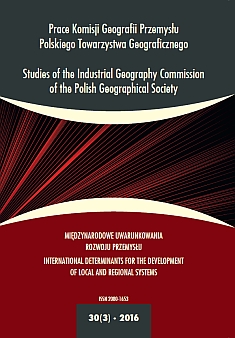Wykorzystanie doświadczeń międzynarodowych dla potrzeb rekultywacji i zagospodarowania zwałowisk odpadów pogórniczych
DOI:
https://doi.org/10.24917/20801653.303.17Słowa kluczowe:
Górnośląskie Zagłębie Węglowe (GZW), odpady pogórnicze, procesy rekultywacyjne, zwałowiska po górnictwie węglowymAbstrakt
Odpady pogórnicze, składowane na zwałowiskach (hałdach) są elementem krajobrazu każdegozagłębia górniczego. Zwałowiska pogórnicze, zarówno podpoziomowe, jak i nadpoziomowe, wymagająefektywnej rekultywacji technicznej i biologicznej oraz racjonalnego zagospodarowania, m.in. w kierunkuparkowo-rekreacyjnym, dydaktycznym i sportowym. Efektywność rekultywacji omawianych obiektów ściślewiąże się z ich negatywnym oddziaływaniem na środowisko, a w szczególności z zagrożeniami samozapłonemi pożarami. Te zagadnienia łączą się również z odzyskiem surowców z odpadów i dotyczą głównie materiiwęglowej. Opisywane obiekty stanowią bowiem bardzo często perspektywiczne antropogeniczne złożawtórne. Procesy odzysku są uzasadnione ekonomicznie, a ich przebieg regulują odpowiednie akty prawne.W artykule przedstawiono doświadczenia z wybranych europejskich zagłębi górniczych (Wielka Brytania- rejon Cardiff, Belgia, Niemcy - Zagłębie Ruhry, Czechy) w zakresie rekultywacji i zagospodarowania zwałowiskpogórniczych. Zaprezentowano kierunki zagospodarowania, możliwe do wykorzystania na zwałowiskachzlokalizowanych na terenie Polski, na przykładzie obszaru Górnośląskiego Zagłębia Węglowego (GZW).Downloads
Metrics
Bibliografia
Gabzdyl, W. (1999). Geologia złóż. Skrypty uczelniane Politechniki Śląskiej, 2163.
Gawor, Ł. (2013). Coal-mining waste dumps as geotourist objects exemplified on Ruhr District and Upper Silesian Coal Basin – comparison and valorization analysis. Cuprum. Czasopismo Naukowo-Techniczne Górnictwa Rud, 3(68), 45–51.
Gawor, Ł. (2014). Coal mining waste dumps as secondary deposits exemplified on Upper Silesian Coal Basin and Lublin Coal Basin. Geology, Geophysis and Environment, 40(3), 285–289.
Gawor, Ł., Warcholik, W., Dolnicki, P. (2014). Możliwości eksploatacji złóż wtórnych (zwałowisk pogórniczych) jako przykład zmian w sektorze przemysłu wydobywczego. Prace Komisji Geografii Przemysłu Polskiego Towarzystwa Geograficznego, 27, 255–265.
Martinec, P. i in. (2005). The effects of coal mining on the landscapes of the Ostrava region. Moravian Geographical Reports, 13(2).
Nita, J., Myga-Piątek, U. (2006). Krajobrazowe kierunki zagospodarowania terenów pogórniczych. Przegląd Geologiczny, 54(3), 256–262.
Nyssen, J., Vermeersch, D. (2010). Slope aspect affects geomorphic dynamics of coal mining spoil heaps in Belgium. Geomorphology, 123(1–2), 109–121.
Ostręga, A. (2004). Nowatorskie rozwiązania w rekultywacji i zagospodarowaniu obszarów poprzemysłowych na przykładzie Zagłębia Ruhry w Niemczech. Przegląd Górniczy, 7–8.
Probierz, K., Marcisz, M., Sobolewski, A. (2012). Od torfu do węgli koksowych monokliny Zofiówki w obszarze Jastrzębia (SW część Górnośląskiego Zagłębia Węglowego). Zabrze: Wydawnictwo Instytutu Chemicznej Przeróbki Węgla.
Schulz, D. (2004). Recultivation of mining waste dumps in the Ruhr area, Germany. W: Water, Air & Soil Pollution, Springer Netherlands, 89–98.
Sikorska-Maykowska, M. (2001). Waloryzacja środowiska przyrodniczego i identyfikacja jego zagrożeń na terenie województwa śląskiego. Katowice: Urząd Marszałkowski Województwa Śląskiego.
Szczepańska, J., Twardowska, I. (1999). Distribution and environmental impact of coal mining wastes in Upper Silesia. Poland. Environmental Geology, 38(3), 249–258.
Tokarska-Guzik, B. (1996). Rola hałd zasadowych w utrzymaniu lokalnej bioróżnorodności. Przegląd Przyrodniczy, 7(3–4), 261–266.
Tokarska-Guzik, B. (2000). Przyrodnicze zagospodarowanie nieużytków miejsko-przemysłowych na przykładzie centrów górniczych Europy. W: Inżynieria Ekologiczna, 1. Ochrona i rekultywacja gruntów. Lublin: Wydawnictwo Ekoinżynieria, 72–80.
Uberman, R., Ostręga, A. (2004) Sposób rekultywacji i zagospodarowania zwałowisk nadkładu i składowisk odpadów górniczych. Górnictwo Odkrywkowe, 7–8.
Zásterová, P., Marschalko, M., Niemiec, D., Durdáka, J., Bulko, R., Vlcekb, J. (2015). Analysis of Possibilities of Reclamation Waste Dumps after Coal Mining. Procedia Earth and Planetary Science, 15.
Pobrania
Opublikowane
Jak cytować
Numer
Dział
Licencja
Artykuły publikowane są zgodnie z warunkami licencji Creative Commons (CC BY-ND 4.0; uznanie autorstwa-bez utworów zależnych).

